Recently, inability to evaluate the technical condition of lightning protection systems facilities installed on wide foundation slabs became a particularly important design problem. The steel support structures of such facilities are usually reliably connected inside the object with the foundation rebars without the option to disconnect them. The ideal solution in such situations would be placing instrumentation connection in wells mounted in the soil (Fig. 8).
In addition, this solution facilitates meeting requirements of 62305 series standards, which state that interconnections between the ground electrode systems should be performed with test clamps, i.e. in the location of drop cables. This method makes it possible to monitor the status of a large foundation slabs during their operation based on the results of the measurement of the ground electrode system active resistance and active resistance between two points of the foundation ground electrode system.
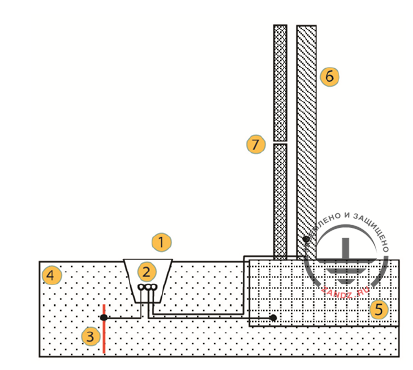
- control and measuring instrumentation well;
- test connection;
- artificial ground electrode system (optional);
- soil;
- foundation;
- steel structure support used as a grounding conductor;
- wall finishing.
Fig. 8. Instrument connection designed to monitor the status of foundation ground electrode system, for example in large facilities with a steel structure (courtesy of RST sp.j.)
Methods to connect an artificial ground electrode system to the foundation ground electrode system
Connecting a foundation ground electrode system to an additional external artificial ground electrode system is related to a problem, which is usually neglected in the design and construction practice. This problem is the wrong selection of materials for artificial grounding, which can create favorable conditions for accelerated corrosion of the grounding system. Designers have very little knowledge on this subject today, despite the fact that respective requirements were introduced back in April 2002 in the PN-IEC 61024-1-2 standard: 2002 [13] in Poland , and in April 2004 the Minister of Infrastructure included this document in the list of standards relating to the technical conditions for buildings and their location [14].
According to the requirements of PN-EN 62305-3, grounding electrodes made of stainless steel or copper can be directly connected to rebars in the concrete. An example of additional artificial ground electrode system built on the basis of copper-bonded GALMAR system and correctly connected to the foundation ground electrode system is shown in Fig. 9.
In view of the risk of corrosion, galvanized ground electrode systems can be connected to rebars in the concrete only through insulating spark gaps able to conduct partial lightning discharges (N class).
Additional requirements for the ground electrode systems that come out of the concrete or soil are as follows:
a. steel grounding electrodes at the transition point to the open air must be protected from corrosion using insulating tapes or heat shrink tubing at a section of 0.3m;
b. such protection is not needed for copper or stainless steel grounding electrodes.
Above normative recommendations mean that today the use of additional galvanized ground electrode systems to connect to foundation ground electrode systems requires from a designer a clear justification of this need, by taking into account both the expected corrosion hazard and the need for additional expensive protective measures (insulation with spark gaps and protective barriers).
Electrochemical corrosion
The corrosion of ground electrode system leads to an increase in active grounding resistance, and in extreme cases even to its complete destruction. Fig.10 b shows an example of a galvanized steel tape laid in the soil and connected with the foundation ground electrode system of an antenna support, which has undergone a very severe corrosion after 12 years of operation. As in the case of combining different materials in the electrical system where it is unacceptable to directly connect aluminum and copper elements, attention should be paid to the selection of appropriate materials for the grounding systems.
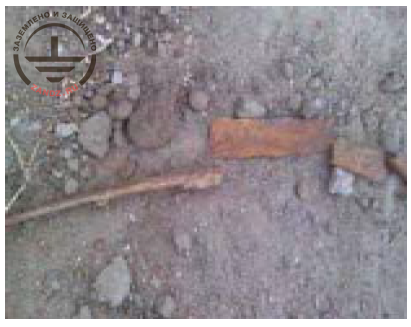
a) The corrosion of a galvanized tape after 6 years of operation as an additional ground electrode on one of the footings of a high voltage 220 kV power transmission line tower in Sudan. One reason for such a rapid corrosion is that it was connected to the foundation rebar of the support;
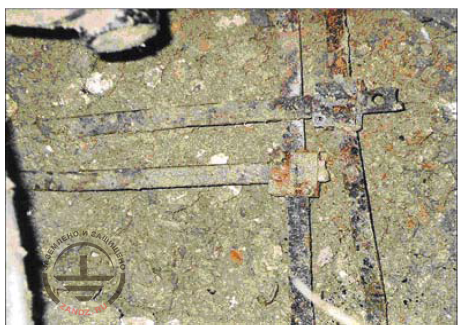
b) A corroded galvanized tape after 12 years of operation as a part of the horizontal element of a ground electrode system at a radio communication facility with a foundation ground electrode system of the mast rod (the mast height is 326 m above the ground) and the footings of its guys (courtesy of RST sp. j.)
Fig. 10. The corrosion of galvanized tape used as an additional grounding electrode of a foundation ground electrode system.
The threat of electrochemical corrosion resulting from the formation of the galvanic link due to the connection of foundation ground electrode system to external galvanized steel ground electrodes is shown in Fig. 11.
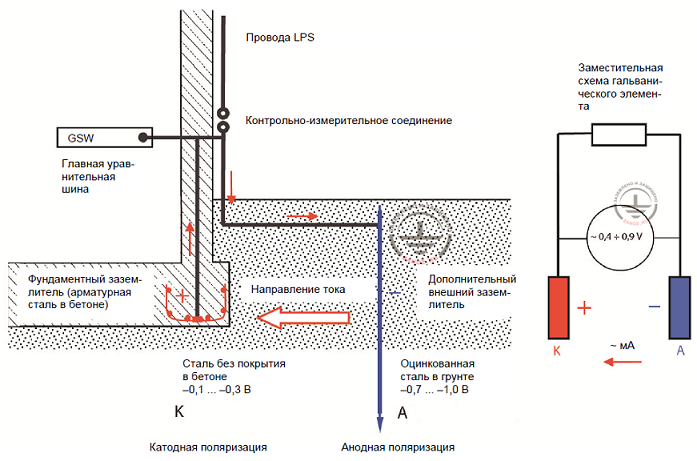
Fig. 11. The threat of electrochemical corrosion as a result of connection of the foundation ground electrode system to external galvanized steel ground electrodes
Different metals are placed in the humid soil or concrete, i.e. in the electrolytic medium, gain different electrical potentials measured relative to the reference electrode. When connected together, different materials create a galvanic cell that can generate the direct current as a result of the difference in potentials. Even if the value of such current is relatively small, just a few milliamperes, it is already a threatening phenomenon because it lasts continuously. It is believed that the potential difference in excess of 0.6 V is creating an environment that facilitates accelerated corrosion. Table 2 lists the values of electromotive force resulting from the combination of different pairs of metals used in ground electrode systems or protective coverings of their elements.
The potential of steel enclosed in the concrete base surrounded by the humid soil measured relative to the Cu / CuSO test electrode4 ranges from -0.1 to -0.3 V [6, 7]. The potential of galvanized steel often used to make artificial ground electrode systems as the cheapest solution placed in the same soil, which is measured against the same test electrode is -0.7 to -1.0 V. This combination results in a potential difference at the level of 0.4-0.9 V. Therefore, the connection of galvanized steel to the steel of foundation ground electrode system is unacceptable as it will accelerate the corrosion of galvanized steel. Copper or copper-bonded steel has a potential close to the potential of steel in the concrete, i.e. in the range from 0 to - 0.2 V.
Recommendations on the selection of materials for artificial ground electrode systems connected to the foundation ground electrode system are contained, in particular, in PN-EN 62305-3 [1] lightning protection standard, as well in PN-HD 60365-5-54 [5] that regulates the grounding of low voltage electric systems.
Table 2. The difference in electrochemical potentials of metal pairs often used in Poland
for the manufacturing of ground electrode systems and their coatings, V
| Zinc and zinc alloys | Zinc on iron or steel, zinc-tin alloy (80/20) | Mild steel | Stainless steel containing 12% chromium; chromium or nickel on steel; tin on steel | Stainless steel with high chromium content | Copper and copper alloys | Types of external coatings |
| 0 | 0,05 | 0,4 | 0,65 | 0,75 | 0,85 | Zinc and zinc alloys |
| 0,05 | 0 | 0,35 | 0,6 | 0,7 | 0,8 | Zinc on iron or steel, zinc-tin alloy (80/20) on steel |
| 0,4 | 0,35 | 0 | 0,25 | 0,35 | 0,45 | Mild steel |
| 0,65 | 0,6 | 0,25 | 0 | 0,1 | 0,2 | Stainless steel containing 12% chromium; chromium or nickel on steel; tin on steel |
| 0,75 | 0,7 | 0,35 | 0,1 | 0 | 0,1 | Stainless steel with high chromium content |
| 0,85 | 0,8 | 0,45 | 0,2 | 0,1 | 0 | Copper and copper alloys |
PN-EN 62305-3: 2009 standard, paragraph E.5.4.3.2 «Foundation ground electrode systems" contanins information about the threat that arises in cases when an external ground electrode system is made of black or galvanized steel: "The following problem is related to electrochemical corrosion under the influence of galvanic currents. The steel in the concrete has approximately the same electrochemical galvanic potential that the copper in the soil. Therefore, when the steel in concrete is connected with the steel in the soil the galvanic voltage occurs, which is approximately equal to 1 V, resulting in the corrosion current flowing in the soil and wet concrete and dissolving the steel in the soil.
If ground electrode system elements placed in the soil are connected with the steel in the concrete, then they should be made of copper or stainless steel.
As it's been already mentioned, the recommendations on the subject were contained in the previous edition of PN-IEC 61024-1 [13] lightning protection standard effective in 2001-2002. In 2004, this standard became mandatory, as it was included in the list of standards related to the technical conditions for buildings and their location [2, 14]. The latest version of PN-EN 62305-3: 2011 extends the wording and allows the use of copper-bonded steel in such cases.
As it's been already mentioned, the recommendations on the subject were contained in the previous edition of PN-IEC 61024-1 [13] lightning protection standard effective in 2001–2002. In 2004, this standard became mandatory, as it was included in the list of standards related to the technical conditions for buildings and their location [2, 14]. The latest version of PN-EN 62305-3: 2011 extends the wording and allows the use of copper-bonded steel in such cases.
Read previous
"Foundation ground electrode systems (Part 1)"
Read next
"Copper-bonded ground electrode systems"
Related Articles:
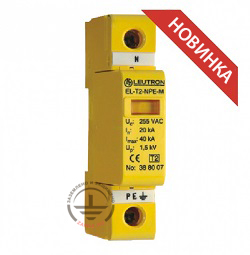 Surge protection device of class 2 EL-T2/0+1-NPE
Surge protection device of class 2 EL-T2/0+1-NPE
 DataPro 2x1
DataPro 2x1



